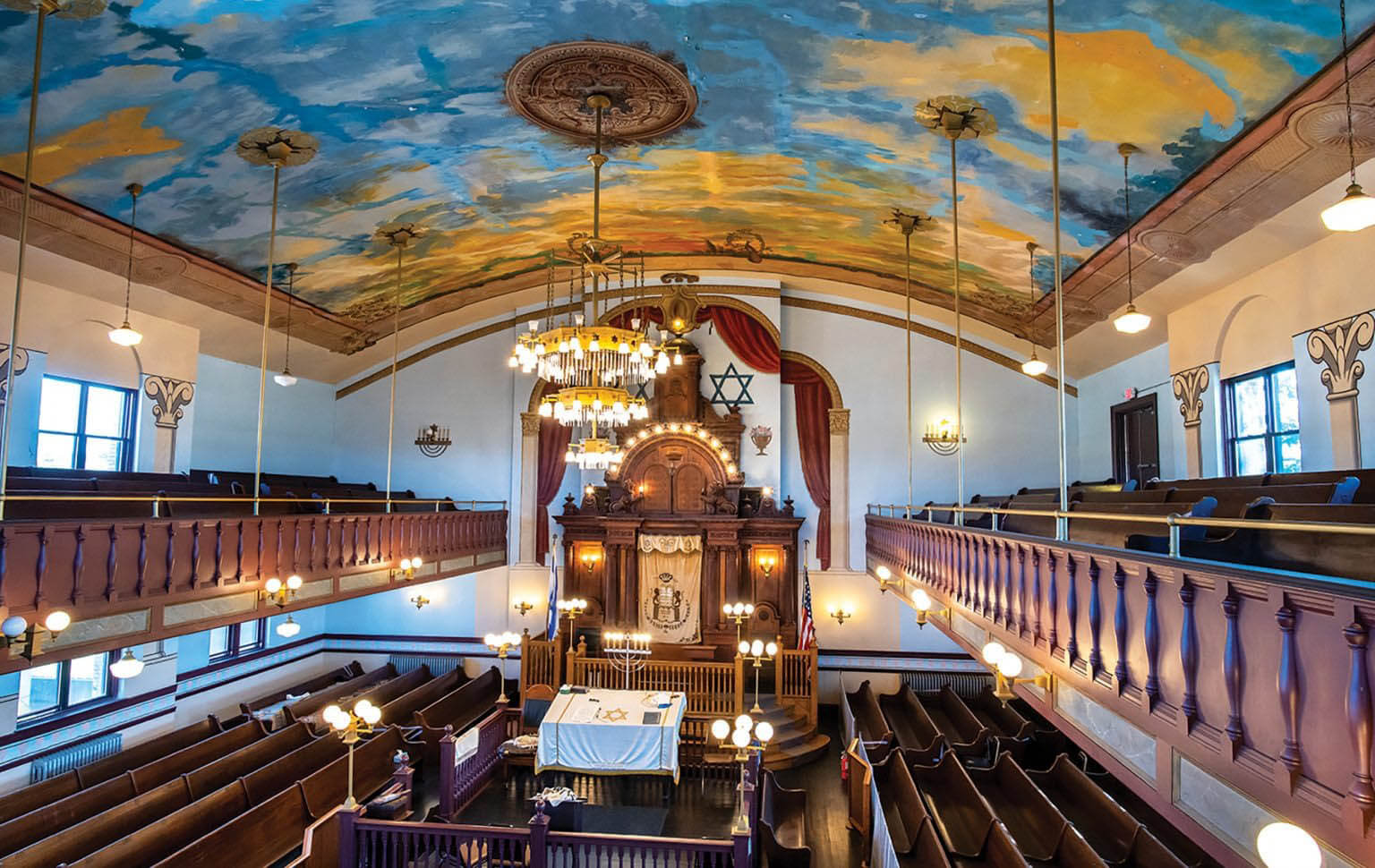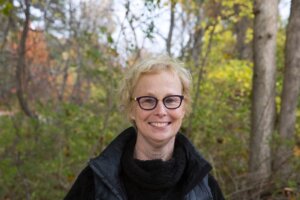Known as the ‘Queen of Shuls,’ it’s missing just one thing: Jews
The synagogue is filled with relics and remnants of immigrant life, a magnificent fresco, a huge, ornate ark and 1,109 seats

Graphic by Angelie Zaslavsky
This article originally appeared in the Jewish Journal of Greater Boston and was reprinted here with permission.
CHELSEA, Mass. — Sheldon Young will turn 93 on Yom Kippur. He is the oldest member of Congregation Agudas Sholom, and each year, on both Rosh Hashanah and Yom Kippur, he makes the long journey back to his home town of Chelsea.
He boards the subway at Kenmore Square, which is near his apartment, then switches at Haymarket to the 111 bus, as he has for the last 60 or so years. He walks several blocks to Walnut Street, and climbs the steep steps of Chelsea’s only surviving Orthodox shul, commonly known as the Walnut Street Shul, where maybe 30 of the 1109 seats will be filled with worshipers this year, hardly any of them from Chelsea.
The synagogue “has always been there for me,” said Young. And he’ll always be there for the synagogue, even as it confronts the sort of wrenching problems that are sinking other congregations. Chief among these is a rapidly declining membership, which at the Walnut Street shul declined even more this month with the death of Young’s 81-year-old brother, Jordan, who had always sat next to him in the front row, left side.
“We’ve had five men pass away in the last 16 months,” said Ed Medros, the synagogue’s tireless president who’s been a member since 1973.
There are other serious challenges faced by this immigrant-era synagogue. By World War I, Chelsea claimed the largest Jewish community in Massachusetts, outside of Boston. It was home to more than 18 shuls during much of the 20th century, and nicknamed “Little Jerusalem.”
Now there are hardly any Jews left in Chelsea, which is “more like Little San Salvador,” said Ellen Rovner, a Chelsea native, cultural anthropologist, and founder of the Chelsea Gateway Project which explores the immigrant history of Chelsea, and its modern legacy, through a Jewish lens.
“The synagogue, built in 1909 by Lithuanian Jews, was known in its heyday as the “Queen of Shuls” in Chelsea. At its peak, around 1945, “each one of the 1109 seats was filled,” said Medros. It is now listed on the National Register of Historic Places. But its structural problems are many. The synagogue has no dedicated parking. It’s not wheelchair accessible. The infrastructure is outdated: They’ve had to enhance security and update the antiquated “knob-and-tube” electrical system which has been obsolete in America since the 1940s. The furnace just died.
And yet the Walnut Street Synagogue still stands proud, its unassuming three-story brick façade intact, thanks to a small core group of diehards led by Medros determined to keep it from suffering the same fate as so many other congregations across the country, including some nearby.
Recently, Temple Emanuel of the Merrimack Valley in Lowell made the decision to dissolve by June 30, 2023, according to a blog post of the Jewish Community Legacy Project which, tellingly, supports small congregations facing operational challenges including those “in a state of decline … [or] facing ultimate closure.”
Among them was Temple B’nai Israel in Revere which closed its doors in 2019 due to declining membership, too little money, and too few volunteers. “No one wanted to step up and be a leader,” said Debby Cherry, who served as the temple’s final president. “The attendance at the High Holidays gets smaller, and the attendance on Friday nights gets smaller, and you know it’s inevitable. The hard part is: When do you make that decision?”
Ed Medros does not want to hear from “inevitable.” Nor does Herb Kupersmith, 83, who had his bar mitzvah at the synagogue in 1952, and has been instrumental in fundraising. “When I was 13 years old, my mother said to me: ‘As long as you are alive, I want you to keep the shul open,’” he said. “I’m proud of the fact that it still is.”
“Being there is an amazing, amazing experience,” said Josh Resnek of Lynn, who does not have an Orthodox background but feels drawn to worship at the synagogue on the High Holidays. His great grandfather Josiah who came to Chelsea from Belorussia in 1885, and his grandfather, Louis, were among the original founders.
“I feel a connection inside the synagogue,” said Resnek. “I sit in the seat where my father and grandfather and great grandfather sat. It’s profound for me. Being there is as close as you can get to being in Eastern Europe. In some respects, the Walnut Street Synagogue is frozen in time, absolutely gorgeous and inspirational.”
* * *
On a recent weekday visit, the synagogue was bustling – not with congregants, but with a team of workmen scurrying to fix the furnace in time for the Holidays. This year, services will be led by a part-time rabbi, Saadi Weisenberg.
Medros, a retired engineer, has been busy, too, cleaning the synagogue, getting the tallitot (prayer shawls) ready, disinfecting prayer books, inspecting all the bulbs on the yahrzeit lights. He calls congregants who don’t have computers to alert them there will be heightened security this year. And he also tries to rally male members of the shul to attend services, in an attempt to guarantee a minyan (The odds, he said, are normally “50-50.”)
Ushering a photographer and reporter into the sanctuary for a tour, Medros paused for the expected gasps of astonishment. He was not disappointed. He points out the women’s balcony on the top floor and the elaborately painted sunrise on the vaulted ceiling, with intricate peacocks looking west over the congregation.
There’s the breathtaking Holy Ark on the eastern wall, made of oak and rising nearly 38 feet, with ornate carvings of animals and symbols from the Torah. It was crafted by Sam Katz, one of a number of gifted Jewish woodcarvers from Eastern Europe who immigrated to America in the late 19th and early 20th centuries and adapted their skills when they got here. They found an eager market for Torah arks and, curiously, wooden carousel horses. So remarkable is Katz’s work that the MFA is in the process of acquiring one of his arks from a private collector for a planned new Judaica gallery, according to Simona Di Nepi, Judaica curator for the Museum of Fine Arts, Boston.
“I’ve traveled and seen some of the most beautiful synagogues in the world, but when I walked into that humble façade, my breath was taken away,” said Rabbi Lila Kagedan, who served as part-time rabbi at the synagogue from 2017-2020. “The history you feel there is remarkable. It’s filled with relics and remnants of a Jewish life that existed on the North Shore, and in such a beautiful space. There is a lot of history in that building.”
This history may be the synagogue’s future. Efforts have begun to create a museum in the building, dedicated to the cultural heritage of the Jewish people in Chelsea. So far, it’s only open by appointment but a portion of the main floor has been set aside for a multifaceted range of artifacts that speak to the city’s Jewish immigrant past.
Here you’ll find the building’s original architectural renderings, and a guide to all of Chelsea’s old synagogues (including the “Carpenters’ Shul” and the “Shmatashe Shul” comprised of clothing workers.) There’s a 60-year-old check from the Chelsea Hebrew Free Loan Association; Judaic ceremonial objects including Torah covers from synagogues that have closed, including from Revere; tools used by Torah scribes; and a 1941 prayer book for Jewish soldiers and sailors.
Also: Such curiousities as a “Halitzah Shoe” used by longtime Chelsea Rabbi Icik Benkovitz as part of a ceremony in which a brother is obliged to marry the widow of his childless brother – or “throw the shoe.” And a large, loud Yiddish banner that would seem more at home in Coney Island: It welcomes “Renowned Cantor Moyshele Soorkis” (aka “The Blind Cantor”) to High Holiday services in 1961.
The museum has not yet been formalized, and is only open by appointment, but Medros is happy to welcome them, as he is anyone who wants to come in and see the sanctuary.
“Every now and then a visitor comes in and says my great grandmother or great grandfather was a member,” he said. “I’ll look up the names and see where they sat or if there is a plaque. I try to make it a meaningful day for them.”
Over the years, accommodations have been made. They have a Shabbat services almost every month with a part-time rabbi, and if they can’t get a minyan, “we don’t give out aliyahs,” said Medros, meaning the honor of reciting the blessing over the Torah.
“Sometimes my husband, who is not Jewish, would come to services to make the minyan,” said Minna Karas-Marino, 80. She remembers when the synagogue was so mobbed on High Holidays “they used to have members walk up and down the aisles and say, “shhhhh, shhhhh.”
It’s not practical to have elderly female congregants climb the stairs to the women’s section, so women now sit downstairs, and they’ve created a mechitza (partition) to separate men from women. Partnerships have formed with various arts and cultural organizations, to sponsor events. There’s an expansive definition of synagogue membership.
“If they have written to us, have come into the synagogue at one time, have been to a Shabbos or High Holiday service, we put them on a mailing list and consider them members,” Medros said.
He will not hear of any thought that it might close. Period.
“It’s a house of worship which has a lot of ties to the community and a lot of people who have ties to the synagogue,” he said. “We will reinvent ourselves as we go along.”
















